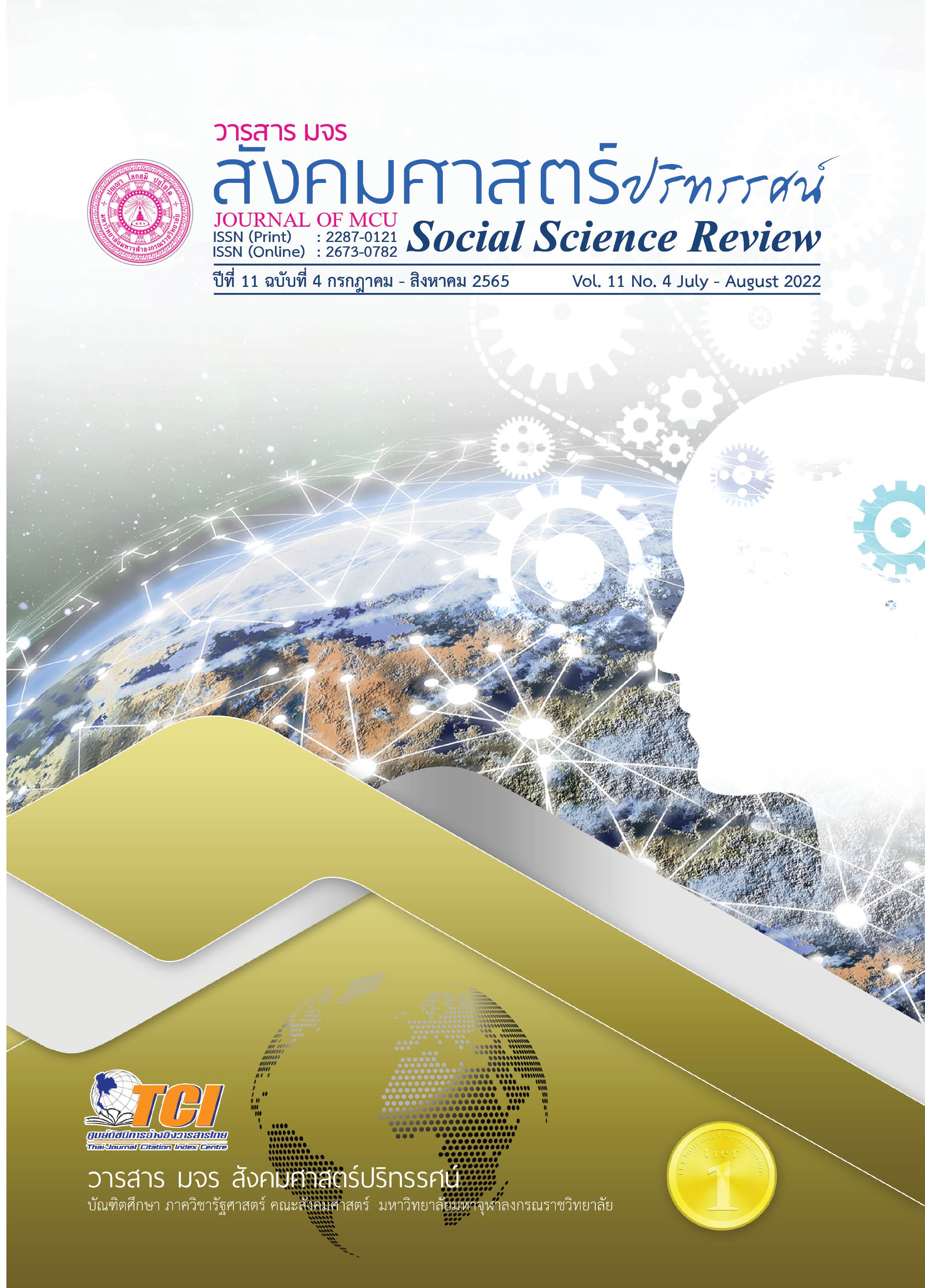ภาพพิมพ์ซิลค์สกรีน : นวัตกรรมพัฒนาทักษะงานศิลปะเชิงพาณิชย์ สู่สังคมไทยยุคดิจิทัลของ วิทยาลัยช่างศิลปสุพรรณบุรี
คำสำคัญ:
สังคมดิจิทัล, ศิลปะภาพพิมพ์, ซิลค์สกรีนบทคัดย่อ
การวิจัยนี้มีวัตถุประสงค์เพื่อ 1. พัฒนานวัตกรรมศิลปะภาพพิมพ์ซิลค์สกรีนด้วยระบบดิจิทัลที่มีมาตรฐานด้านอาชีพเป็นนวัตกรรมเรียนรู้ตลอดชีวิตแก่ผู้เรียนและบุคคลทั่วไป และ 2.เสนอแนวการจัดการศึกษาศิลปวัฒนธรรมรูปแบบศิลปะ 4.0 แก่สถานศึกษาและบุคคลทั่วไป เป็นรูปแบบการวิจัยและพัฒนา เครื่องมือเป็นการทดลองและปฏิบัติการตามกระบวนการงานซิลค์สกรีนบนสื่อเทคโนโลยียูทูป เก็บข้อมูลด้วยแบบสัมภาษณ์ การสังเกตและการประเมินนวัตกรรม ประชากรประกอบด้วยศิลปิน ครูศิลปะและผู้เรียน จำนวน 28 คน กลุ่มทดลองเป็นนักศึกษาระดับปริญญาตรี จำนวน 20 คน ของวิทยาลัยช่างศิลปสุพรรณบุรี ตามแนวคิดทางสังคมและศิลปะสมัยใหม่
ผลการวิจัยพบว่า 1. นวัตกรรมได้พัฒนาทักษะผู้เรียนศิลปะ ได้แก่ การออกแบบ เทคโนโลยี การสร้างสรรค์ แนวคิดและการพัฒนาผลงานศิลปะในงานวิจัยจากสภาพทางสังคมด้วยประสบการณ์ได้เป็นแม่พิมพ์ต้นแบบซิลค์สกรีน คือ ภาพสะท้อนการแพร่เชื้อไวรัสโควิด-19 2. แนวทางในการจัดการศึกษาศิลปวัฒนธรรมในรูปแบบศิลปะ 4.0 ได้แก่ การพัฒนาทักษะศิลปะเพื่อสร้างรายได้จากทุนสร้างสรรค์ การใช้สื่อดิจิทัลกับงานสร้างสรรค์, การส่งเสริมการเรียนรู้งานศิลปะเพื่ออาชีพหรือเป็นศิลปิน และการส่งเสริมปลูกฝังให้บุคคลมีความสุนทรีย์ในการเรียนรู้ตามหลักวิชาและการใช้ชีวิต นวัตกรรมมีมาตรฐานด้านอาชีพและผู้เรียนมีความพึงพอใจมากที่สุด เหมาะสมกับสถานศึกษาและบุคคลนำไปประยุกต์ใช้เรียนรู้งานอาชีพศิลปะได้ทุกสาขาและวิชาชีพอื่น ๆ
เอกสารอ้างอิง
กำจร สุนพงษ์ศรี. (2559). สุนทรียศาสตร์ (พิมพ์ครั้งที่ 3). กรุงเทพฯ: จุฬาลงกรณ์มหาวิทยาลัย.
ชนากานต์ สุวรรณรัตนศรี และคณะ. (2562). คุณลักษณะอันพึงประสงค์ของบุคลากรในยุคประเทศไทย 4.0. นครราชสีมา: วิทยาลัยนครราชสีมา.
ชาตรี บัวคลี่. (2556). แนวคิดการออกแบบสิ่งพิมพ์ดิจิทัลหลังสมัยใหม่. อิเล็กทรอนิกส์ Veridian มหาวิทยาลัยศิลปากร (มนุษยศาสตร์สังคมศาสตร์และศิลปะ), 7(3), 247-258.
เดชา หวังมี. (2550). ความต้องการในการเรียนรู้ตลอดชีวิตของประชาชนในชนบท: กรณีศึกษาจังหวัดพังงา. (วิทยานิพนธ์ศึกษาศาสตร์มหาบัณฑิต สาขาวิชาศึกษาศาสตร์เพื่อพัฒนาชุมชน). สงขลา: มหาวิทยาลัยสงขลานครินทร์.
เทิดศักดิ์ เหล็กดี. (2556). ความเสื่อม. กรุงเทพ: มหาวิทยาลัยศิลปากร.
ธัญธัช วิภัติภูมิประเทศ. (2562). สังคมวิทยาดิจิทัล: แนวคิดและการนำไปใช้. วารสารราชภัฏสุราษฎร์ธานี, 6(3), 43-56.
นิอัลยา สาอุ และไพโรจน์ ภัทรนรากุล. (2564). การเรียนรู้ทางไกลเชิงนวัตกรรม: การพัฒนาการเรียนรู้ในยุคดิจิทัล: กรอบสู่ SDGs. วารสารอิเล็กทรอนิกส์การเรียนรู้ทางไกลเชิงนวัตกรรม, 11(2),19-29.
ปัติมา โฆษิตเกษม. (2564) ภาพพิมพ์ซิลค์สกรีน: นวัตกรรมพัฒนาทักษะงานศิลปะเชิงพาณิชย์สู่สังคมไทยยุคดิจิทัล. นครปฐม: สถาบันบัณฑิตพัฒนศิลป์.
ระวีวรรณ สระทองอั๋น. (2556). ความสุขในความสงบเงียบ. (ศิลปะนิพนธ์มหาบัณฑิต สาขาทัศนศิลปศึกษา). นครปฐม: มหาวิทยาลัยศิลปากร.
สุธี คุณาวิชยานนท์. (2561). ศิลปะสมัยใหม่และร่วมสมัย: ตะวันตกและไทย. กรุงเทพฯ: เจ พริ้นท์.
เสาวลักษณ์ พันธบุตร. (2560). อยู่อย่างคนร่วมสมัยในยุคดิจิทัล Living Contemporaly in the Digital Age. วารสารวิชาการนวัตกรรมสื่อสารสังคม, 5(2), 161-167.
วิรุณ ตั้งเจริญ. (2547). ศิลปะหลังสมัยใหม่. กรุงเทพฯ: อีแอนด์ไอคิว.
อัศนีย์ ชูอรุณ. (2554). ประวัติและแบบอย่างศิลปิน. กรุงเทพฯ: โอเดียนสโตร์.
Lupton, D. (2013). Digital Sociology: Beyond the Digital to the Sociological. Retrieved October 2, 2021, from https://www.slideshare.net/dlupton/ digital-sociolog-beyond-the-digital-to-thesociological
ดาวน์โหลด
เผยแพร่แล้ว
รูปแบบการอ้างอิง
ฉบับ
ประเภทบทความ
สัญญาอนุญาต
ลิขสิทธิ์ (c) 2022 วารสาร มจร สังคมศาสตร์ปริทรรศน์

อนุญาตภายใต้เงื่อนไข Creative Commons Attribution-NonCommercial-NoDerivatives 4.0 International License.
เพื่อให้เป็นไปตามกฎหมายลิขสิทธิ์ ผู้นิพนธ์ทุกท่านต้องลงลายมือชื่อในแบบฟอร์มใบมอบลิขสิทธิ์บทความให้แก่วารสารฯ พร้อมกับบทความต้นฉบับที่ได้แก้ไขครั้งสุดท้าย นอกจากนี้ ผู้นิพนธ์ทุกท่านต้องยืนยันว่าบทความต้นฉบับที่ส่งมาตีพิมพ์นั้น ได้ส่งมาตีพิมพ์เฉพาะในวารสาร มจร สังคมศาสตร์ปริทรรศน์ เพียงแห่งเดียวเท่านั้น หากมีการใช้ภาพหรือตารางหรือเนื้อหาอื่นๆ ของผู้นิพนธ์อื่นที่ปรากฏในสิ่งตีพิมพ์อื่นมาแล้ว ผู้นิพนธ์ต้องขออนุญาตเจ้าของลิขสิทธิ์ก่อน พร้อมทั้งแสดงหนังสือที่ได้รับการยินยอมต่อบรรณาธิการ ก่อนที่บทความจะได้รับการตีพิมพ์ หากไม่เป็นไปตามข้อกำหนดเบื้องต้น ทางวารสารจะถอดบทความของท่านออกโดยไม่มีข้อยกเว้นใดๆ ทั้งสิ้น





